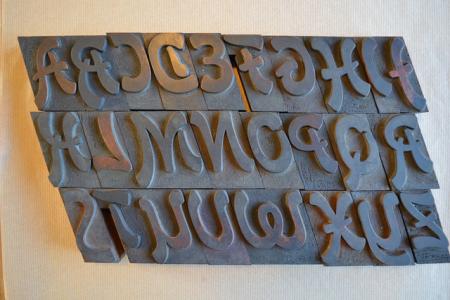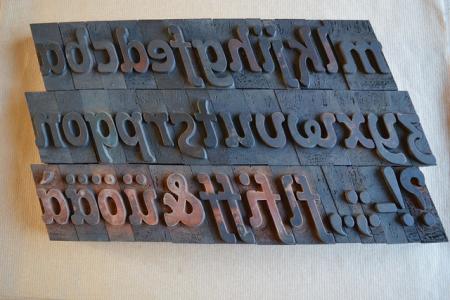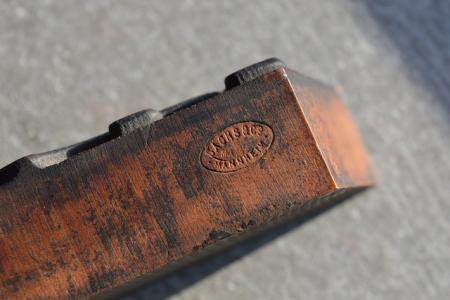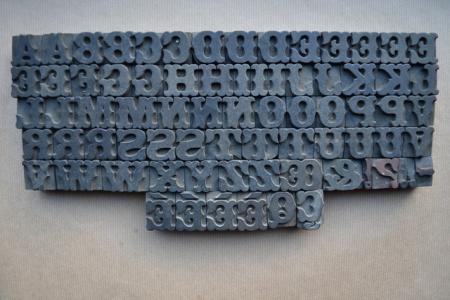Wich type (wood, european)
Hi all
My first post here. I recently bought some wood type (Belgium, Europe), and I am trying to identify which type they are.
- The first three photo’s show a type i bought in Brussels. The type has Dutch height. A stamp on the side of a capital A says ‘Sachs & Co, Mannheim’. Looking for it on ggl produced the cover of a specimen book, 1902. I’d love to find that book!
- The fourth photo shows another type I recently bought. It’s a small type (5 1/2 cicero, 66 points).
Has anyone seen these types, do they have a name, where can I find more information? With gratitude!
Niels

sacs_&_co_1.jpg

sachs_&_co_2.jpg

sachs_&_co_3.jpg

small_wood_type.jpg
Niels,
Hello from England. The first type is called here in England Regina, the non-italic was called Victoria. I had it in lead type. The small one is known as a tuscan here but probably a different name in Belgium.
I will visit Antwerp next week. I have a friend there with much printing equipment. You should visit!
Best Wishes,
Jeremy.
I have been doing quite a bit of research on the wood used to cut wood type, both here in the United States and in the rest of the world. Knowing of my interest, my daughter photographed the technical, ordering page in several very old specimen books at the St. Brides Library.
From the color and grain of the wood your photos show I would say the wood used for both type is Swiss Pear. This was historically used for end grain in Europe. It does not have the proper color for imported English Boxwood.
I love the Victoria font. From a type cutting point of view very ornate but very few sharp corners, and almost all small radius corners. Maybe a future type cutting project.
Scott
I have been doing quite a bit of research on the wood used to cut wood type, both here in the United States and in the rest of the world. Knowing of my interest, my daughter photographed the technical, ordering page in several very old specimen books at the St. Brides Library.
From the color and grain of the wood your photos show I would say the wood used for both type is Swiss Pear. This was historically used for end grain in Europe. It does not have the proper color for imported English Boxwood.
I love the Victoria font. From a type cutting point of view very ornate but very few sharp corners, and almost all small radius corners. Maybe a future type cutting project.
Scott
I have been doing quite a bit of research on the wood used to cut wood type, both here in the United States and in the rest of the world. Knowing of my interest, my daughter photographed the technical, ordering page in several very old specimen books at the St. Brides Library.
From the color and grain of the wood your photos show I would say the wood used for both type is Swiss Pear. This was historically used for end grain in Europe. It does not have the proper color for imported English Boxwood.
I love the Victoria font. From a type cutting point of view very ornate but very few sharp corners, and almost all small radius corners. Maybe a future type cutting project.
Scott
I have been doing quite a bit of research on the wood used to cut wood type, both here in the United States and in the rest of the world. Knowing of my interest, my daughter photographed the technical, ordering page in several very old specimen books at the St. Brides Library.
From the color and grain of the wood your photos show I would say the wood used for both type is Swiss Pear. This was historically used for end grain in Europe. It does not have the proper color for imported English Boxwood.
I love the Victoria font. From a type cutting point of view very ornate but very few sharp corners, and almost all small radius corners. Maybe a future type cutting project.
Scott
Sorry about the duplication. How do you remove a comment or reply such as this duplication of mine? Even Rick does not know.
Scott
Scott, not sure if you can remove the post entirely, but you should be able to edit it and remove the body of the post, that way it’ll take up less space and be less distracting :)
That last font is stunning, Niels. A great find!
Thx Jeremy and Scott!